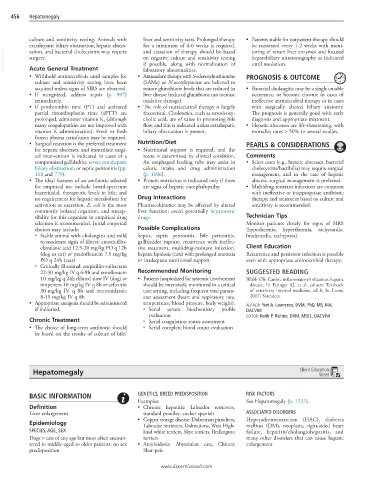Page 931 - Cote clinical veterinary advisor dogs and cats 4th
P. 931
456 Hepatomegaly
culture and sensitivity testing. Animals with liver and sensitivity tests. Prolonged therapy • Patients stable for outpatient therapy should
extrahepatic biliary obstruction, hepatic absces- for a minimum of 4-6 weeks is required, be reassessed every 1-2 weeks with moni-
VetBooks.ir surgery. on negative culture and sensitivity testing hepatobiliary ultrasonography as indicated
and cessation of therapy should be based
toring of serum liver enzymes and focused
sation, and bacterial cholecystitis may require
if possible, along with normalization of
until resolution.
Acute General Treatment
laboratory abnormalities.
• Withhold antimicrobials until samples for • Antioxidant therapy with S-adenosylmethionine PROGNOSIS & OUTCOME
culture and sensitivity testing have been (SAMe) or N-acetylcysteine are believed to
acquired unless signs of SIRS are observed. restore glutathione levels that are reduced in • Bacterial cholangitis may be a single curable
• If recognized, address sepsis (p. 907) liver disease (reduced glutathione can increase occurance, or become chronic in cases of
immediately. oxidative damage). ineffective antimicrobial therapy or in cases
• If prothrombin time (PT) and activated • The role of nutraceutical therapy is largely with surgically altered biliary anatomy.
partial thromboplastin time (aPTT) are theoretical. Choleretics, such as ursodeoxy- The prognosis is generally good with early
prolonged, administer vitamin K 1 (although cholic acid, are of value in promoting bile diagnosis and appropriate treatment.
many coagulopathies are not improved with flow, and this is indicated unless extrahepatic • Hepatic abscesses are life-threatening, with
vitamin K administration). Fresh or fresh biliary obstruction is present. mortality rates > 50% in several studies.
frozen plasma transfusion may be required.
• Surgical resection is the preferred treatment Nutrition/Diet PEARLS & CONSIDERATIONS
for hepatic abscesses, and immediate surgi- • Nutritional support is required, and the
cal intervention is indicated in cases of a route is determined by clinical condition. Comments
compromised gallbladder, severe extrahepatic An esophageal feeding tube may assist in • Select cases (e.g., hepatic abscesses, bacterial
biliary obstruction, or septic peritonitis (pp. caloric intake and drug administration cholecystitis/bactibilia) may require surgical
118 and 779). (p. 1106). management, and in the case of hepatic
• The ideal features of an antibiotic selected • Protein restriction is indicated only if there abscess, surgical management is preferred.
for empirical use include broad-spectrum are signs of hepatic encephalopathy. • Multidrug-resistant infections are common
bactericidal, therapeutic levels in bile, and with ineffective or inappropriate antibiotic
no requirement for hepatic metabolism for Drug Interactions therapy, and treatment based on culture and
activation or excretion. E. coli is the most Pharmacokinetics may be affected by altered sensitivity is recommended.
commonly isolated organism, and suscep- liver function; avoid potentially hepatotoxic
tibility for this organism in empirical drug drugs. Technician Tips
selection is recommended. Initial empirical Monitor patients closely for signs of SIRS
choices may include: Possible Complications (hypothermia, hyperthermia, tachycardia,
○ Stable animal with cholangitis and mild Sepsis, septic peritonitis, bile peritonitis, bradycardia, tachypnea).
to moderate signs of illness: amoxicillin- gallbladder rupture, recurrence with ineffec-
clavulanic acid 12.5-20 mg/kg PO q 12h tive treatment, multidrug-resistant infection, Client Education
(dog or cat) or pradofloxacin 7.5 mg/kg hepatic lipidosis (cats) with prolonged anorexia Recurrence and persistent infection is possible
PO q 24h (cats) or inadequate nutritional support even with appropriate antimicrobial therapy.
○ Critically ill animal: ampicillin-sulbactam
22-30 mg/kg IV q 6-8h and enrofloxacin Recommended Monitoring SUGGESTED READING
10 mg/kg q 24h diluted slow IV (dog) or • Patients hospitalized for systemic involvement Webb CB: Canine inflammatory/infectious hepatic
imipenem 10 mg/kg IV q 8h or cefoxitin should be intensively monitored in a critical disease. In Ettinger SJ, et al, editors: Textbook
30 mg/kg IV q 8h and metronidazole care setting, including frequent vital param- of veterinary internal medicine, ed 8, St. Louis,
8-15 mg/kg IV q 8h eter assessment (heart and respiratory rate, 2017, Saunders.
• Appropriate analgesia should be administered temperature, blood pressure, body weight). AUTHOR: Yuri A. Lawrence, DVM, PhD, MS, MA,
if indicated. ○ Serial serum biochemistry profile DACVIM
evaluation EDITOR: Keith P. Richter, DVM, MSEL, DACVIM
Chronic Treatment ○ Serial coagulation status assessment
• The choice of long-term antibiotic should ○ Serial complete blood count evaluation
be based on the results of culture of bile/
Hepatomegaly Client Education
Sheet
BASIC INFORMATION GENETICS, BREED PREDISPOSITION RISK FACTORS
Examples: See Hepatomegaly (p. 1231).
Definition • Chronic hepatitis: Labrador retrievers,
Liver enlargement standard poodles, cocker spaniels ASSOCIATED DISORDERS
• Copper storage disease: Doberman pinschers, Hyperadrenocorticism (HAC), diabetes
Epidemiology Labrador retrievers, Dalmations, West High- mellitus (DM), neoplasia, right-sided heart
SPECIES, AGE, SEX land white terriers, Skye terriers, Bedlington failure, hepatitis/cholangiohepatitis, and
Dogs > cats of any age but most often encoun- terriers many other disorders that can cause hepatic
tered in middle-aged to older patients; no sex • Amyloidosis: Abyssinian cats, Chinese enlargement
predisposition Shar-peis
www.ExpertConsult.com

